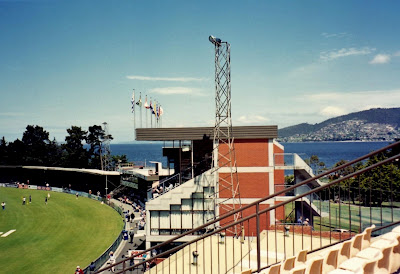Posted by Tony Hutton
Christmas 2021 will certainly not be one to remember for Yorkshire cricket followers. The existing problems of both Yorkshire and England had already cast a huge shadow over proceedings before the sad death of Raymond Illingworth was announced. Already his considerable achievements with England, Yorkshire and Leicestershire have been listed in some excellent obituaries elsewhere, so I will content myself with brief memories of a conversation I had with him only a few years ago. In addition I am also able to recollect brief encounters with Fred Trueman, Brian Close and Geoffrey Boycott.
The picture below is from a painting by John Blakey of probably the four greatest Yorkshire cricketers of my lifetime which was reproduced in Chris Waters' excellent book on Fred Trueman. The first chapter of the book recalls the reunion lunch conversation between the four, who had often not agreed in the past, but were in slightly mellower mood in 2005.
 |
| Four Yorkshire cricket legends. |
I met both Boycott and Illingworth at the Headingley Test Match in 2010 when Australia played Pakistan. Boycott, who had become a friend of my son's during his television work in India, had invited him and myself as his guests for lunch in the pavilion. Geoffrey was the perfect host and made quite a fuss of us both, even to the extent of getting our drinks from the bar.
Australia were rather swiftly bowled out for 88 on the first morning and I think during the interval between innings I noticed Raymond was sitting on his own and took the liberty of introducing myself and asking him how Farsley were getting on in the Bradford League. He seemed delighted to talk to someone with some knowledge of the Bradford League and we chatted for quite a while about a subject which was obviously always close to his heart.
I did not have the temerity to bore him with my personal memories of seeing him play, but now recall I first saw him back in the 1950s playing for Yorkshire Seconds against Staffordshire at Walsall. I then saw quite a lot of him at Bramall Lane, during my time at Sheffield in the late sixties and early seventies. He always seemed to make runs when Yorkshire were in trouble and I remember several fifties and sixties in county games around that time.
However it was his off spin bowling which won so many games for Yorkshire and most notable of all was his performance in 1968 when Yorkshire beat Australia at Bramall Lane, taking four wickets in each innings, including those of Bill Lawry and Ian Chappell.
It was also at a Sheffield occasion that I was introduced to Fred Trueman, as far back as 1973 when a celebration dinner was held at the City Hall to mark the last match at Bramall Lane. Again I was fortunate to have been invited as a guest by my then business colleague, Frank Lowson, who of course made his first appearance for Yorkshire alongside Fred and Brian Close back in 1949.
Frank introduced me to the great man, who was already in full flow with endless complaints against the then Yorkshire committee, as well as one Geoffrey Boycott. Obviously the two did not get on for many years and it was a relief to read in Chris Waters' book many years later of their reconciliation in 2005. In an evening when I met many cricketers from both sides of the Pennines, it was obviously my boyhood hero Fred who stood out and I was rendered almost speechless, unable to get much of a word in anyway.
 |
| Close, Illingworth and Trueman in the centre with Boycott extreme right at Lord's 1965. |
Some years after that I got to meet Brian Close at a Tilcon Trophy game at Harrogate cricket club, where four counties regularly played a mid-season friendly, one day competition. It was not taken very seriously, certainly not by Brian Close who was scheduled to nominate the man of the match, but as usual spent most of his time studying the Racing Post and on the phone to his bookie, rather than watching the cricket.
As my employer was one of the sponsors, with our own tent to entertain our guests, my wife and I were invited to the pavilion lunch with both Close and Trueman in attendance. Their two wives certainly made a hit with my wife, but obviously the two cricketers had seen it all before and did not get very involved in the social niceties. However as the game neared it's conclusion Close obviously realised that I had been following the play from the pavilion balcony and asked me who he should choose as 'Man of the Match'.
I was able to point out that a young Australian, playing for Leicestershire, had made top score of the day and won the match. This was non other than Mike Haysman, who has now achieved fame as a cricket commentator in South Africa. Mr Close duly gave him the award, so one of my rare claims to fame is that I gave cricketing advice to not only a former captain of Yorkshire, but a former captain of England as well.



















































